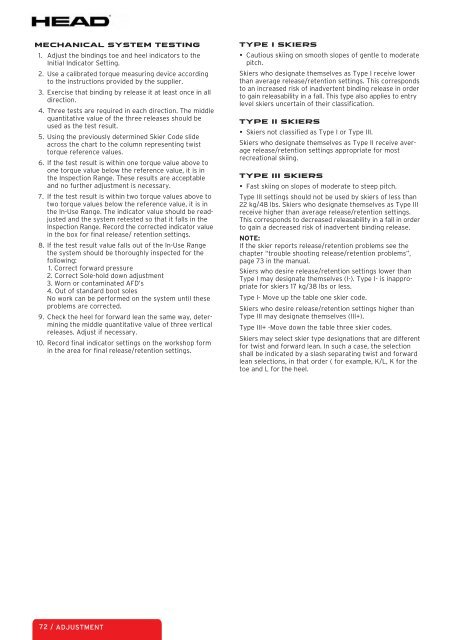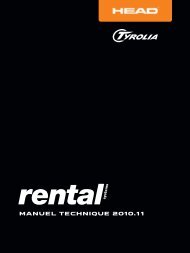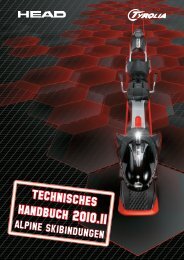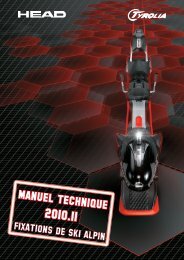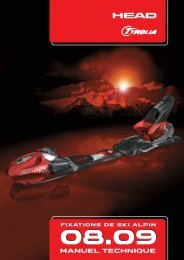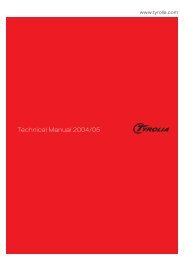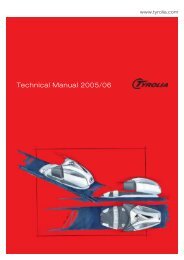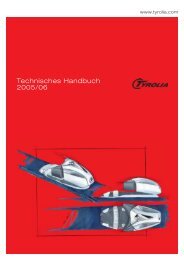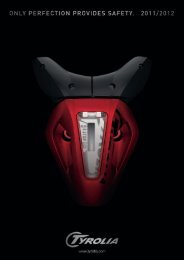You also want an ePaper? Increase the reach of your titles
YUMPU automatically turns print PDFs into web optimized ePapers that Google loves.
Mechanical System Testing<br />
1. Adjust the bindings toe and heel indicators to the<br />
Initial Indicator Setting.<br />
2. Use a calibrated torque measuring device according<br />
to the instructions provided by the supplier.<br />
3. Exercise that binding by release it at least once in all<br />
direction.<br />
4. Three tests are required in each direction. The middle<br />
quantitative value of the three releases should be<br />
used as the test result.<br />
5. Using the previously determined Skier Code slide<br />
across the chart to the column representing twist<br />
torque reference values.<br />
6. If the test result is within one torque value above to<br />
one torque value below the reference value, it is in<br />
the Inspection Range. These results are acceptable<br />
and no further adjustment is necessary.<br />
7. If the test result is within two torque values above to<br />
two torque values below the reference value, it is in<br />
the In-Use Range. The indicator value should be readjusted<br />
and the system retested so that it falls in the<br />
Inspection Range. Record the corrected indicator value<br />
in the box for final release/ retention settings.<br />
8. If the test result value falls out of the In-Use Range<br />
the system should be thoroughly inspected for the<br />
following:<br />
1. Correct forward pressure<br />
2. Correct Sole-hold down adjustment<br />
3. Worn or contaminated AFD’s<br />
4. Out of standard boot soles<br />
No work can be performed on the system until these<br />
problems are corrected.<br />
9. Check the heel for forward lean the same way, determining<br />
the middle quantitative value of three vertical<br />
releases. Adjust if necessary.<br />
10. Record final indicator settings on the workshop form<br />
in the area for final release/retention settings.<br />
72 / ADJUSTMENT<br />
TYPE I SKIERS<br />
• Cautious skiing on smooth slopes of gentle to moderate<br />
pitch.<br />
Skiers who designate themselves as Type I receive lower<br />
than average release/retention settings. This corresponds<br />
to an increased risk of inadvertent binding release in order<br />
to gain releasability in a fall. This type also applies to entry<br />
level skiers uncertain of their classification.<br />
TYPE II SKIERS<br />
• Skiers not classified as Type I or Type III.<br />
Skiers who designate themselves as Type II receive average<br />
release/retention settings appropriate for most<br />
recreational skiing.<br />
TYPE III SKIERS<br />
• Fast skiing on slopes of moderate to steep pitch.<br />
Type III settings should not be used by skiers of less than<br />
22 kg/48 lbs. Skiers who designate themselves as Type III<br />
receive higher than average release/retention settings.<br />
This corresponds to decreased releasability in a fall in order<br />
to gain a decreased risk of inadvertent binding release.<br />
NOTE:<br />
If the skier reports release/retention problems see the<br />
chapter “trouble shooting release/retention problems”,<br />
page 73 in the manual.<br />
Skiers who desire release/retention settings lower than<br />
Type I may designate themselves (I-). Type I- is inappropriate<br />
for skiers 17 kg/38 lbs or less.<br />
Type I- Move up the table one skier code.<br />
Skiers who desire release/retention settings higher than<br />
Type III may designate themselves (III+).<br />
Type III+ -Move down the table three skier codes.<br />
Skiers may select skier type designations that are different<br />
for twist and forward lean. In such a case, the selection<br />
shall be indicated by a slash separating twist and forward<br />
lean selections, in that order ( for example, K/L, K for the<br />
toe and L for the heel.


